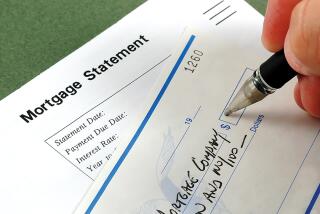equity loans still scarce
Traditional 30-year mortgages these days are unusually affordable by historical standards, but if you’re looking for a home equity line of credit, don’t expect any deals.
The market for such credit lines, which practically shut down as home prices tumbled, remains tight as a drum despite signs of life in the rest of the home loan market. And offers that let you pay only the prime rate or just above that benchmark are long gone.
“The days of lenders falling all over themselves to help you empty the equity out of your home aren’t coming back any time soon,” said Keith Gumbinger, vice president at loan data tracker HSH Associates.
Even for homeowners with plenty of home equity still available, “access to it is harder to come by,” Gumbinger said. “You need to be a much higher-quality borrower now. And if you can get it, the terms are going to be a lot less attractive.”
Before the housing boom, home equity credit lines were a cheap way for homeowners to renovate their property, pay college tuition or buy a car. During the boom, they also were often used to make a down payment on a home or to finance a vacation or other indulgences.
But banks are still reeling from huge losses on these credit lines, which -- as a type of second mortgage -- almost always become worthless when “underwater” borrowers slide into foreclosure. And the tide of losses is a long way from ebbing; Bank of America Corp., for example, wrote off $1.97 billion in home equity debt as uncollectable in the third quarter of this year, up $130 million from the second quarter.
As their losses grew, lenders began freezing equity credit lines -- halting withdrawals -- in early 2008. And the practice hasn’t stopped, as Anne and Marc Pelini discovered.
The Pelinis obtained a $50,000 credit line from JPMorgan Chase & Co.’s Chase unit last fall to finance more work on the Chicago home they bought in 2001. They promptly used $7,000 on a new furnace. In August, Chase sent them a letter saying the remaining $43,000 had been cut off.
A new appraisal done by computer, which Chase said “did not require an appraiser to enter your home,” indicated the home’s value had plunged 29% in nine months -- a drop the Pelinis strongly dispute.
According to the S&P;/Case-Shiller indexes, home prices in Chicago were down only 12.7% in August from a year earlier. Chase spokesman Thomas A. Kelly said borrowers in a situation like the Pelinis could hire a Chase-approved appraiser to do a valuation, “and we will pay for it if it shows we should reinstate the line.”
A series of lawsuits filed in Illinois have accused Chase, Wells Fargo & Co. and other banks of using unreliable computer models that inaccurately determined borrowers’ home values in order to cut off their credit lines, and failing to provide a proper appeal process when the lines were cut. Chase has filed a motion to dismiss its case; Wells said it was “confident in our fair and responsible lending practices.”
Credit cut-offs aren’t the only nasty surprises in the home equity realm nowadays. Homeowners who got used to being offered credit lines at the prime rate or sometimes significantly lower a few years back are now out of luck when they search for such deals.
New credit lines are still available -- but only to solid-credit borrowers who document every dollar of income, and only if the total mortgage debt doesn’t exceed 55% to 80% of a home’s value, down from 100% at the heady peak of the bubble, Gumbinger said.
And whereas borrowers commonly paid half a percentage point more than the prime rate in 2006 and 2007, the average rate recently has been well above 2 points over prime. According to Bankrate.com, the rate on a $30,000 home equity credit line averaged 5.33% this week, compared with 3.25% for the prime rate.
Back in the glory days, nearly half of all home lenders offered their best customers credit lines at or under the prime rate, and many tempted borrowers with ultra-low initial rates -- say, 2% for the first six months. Today, the few equity credit lines advertised at or under the prime rate include a “floor,” typically 5%, beneath which the rate can’t drop, Gumbinger said.
Not surprisingly, fewer home equity credit lines and home equity loans are being granted. According to National Mortgage News, the dollar amount of these second liens, as they are called, tumbled 75% from the second quarter of 2008 compared with the same period this year.
The decline in volume reflects lower demand from recession-chastened consumers as well as their shrinking home equity and banks’ tightened lending standards, lenders and economists say.
Another shocker for many borrowers is how hard it can be to hang on to a credit line when refinancing a first mortgage. Such a maneuver requires the credit-line lender to agree to keep the debt subordinated to the new first mortgage -- lower in repayment priority if the borrower goes into default. But credit-line issuers are now loath to agree to that, according to lenders, brokers and homeowners.
Dale Johnson, a Napa homeowner whose first mortgage with Bank of America is just $64,000, said he got a $250,000 credit line from BofA in March to make some investments.
Johnson said he told BofA recently that he planned to refinance his first mortgage with another lender, increasing it by $50,000 and reducing his credit line balance at BofA by the same amount.
BofA initially said it would subordinate the credit line only if Johnson were to agree to a hike of 1.25 percentage points in its interest rate. BofA’s senior vice president for home equity lending, Peggy Lawlor, said it was customary to raise the rate on a second mortgage when the first mortgage’s balance rose in a refinancing, because that created a greater risk for the holder of the second loan.
But after a reporter asked BofA about Johnson’s situation, the lender agreed to let him keep his interest rate.
Some observers say the worst of the crunch for home equity loans may be in sight.
“They’re still tight but they’re not getting tighter and tighter and tighter,” said former Bank of America economist Lynn Reaser, now at Point Loma Nazarene University in San Diego.
Some lenders are now gingerly expressing interest in expanding their home equity portfolios, but only in certain improving housing markets, said Kevin Petrasic, a private lawyer specializing in banking.
But home equity lending won’t return to normal until it’s clear that housing prices have bottomed nationally, said Barbara J. DeSoer, head of Bank of America’s mortgage operation.
And that is something that BofA -- and many other lenders -- don’t expect to happen until well into next year.
--
More to Read
Inside the business of entertainment
The Wide Shot brings you news, analysis and insights on everything from streaming wars to production — and what it all means for the future.
You may occasionally receive promotional content from the Los Angeles Times.











